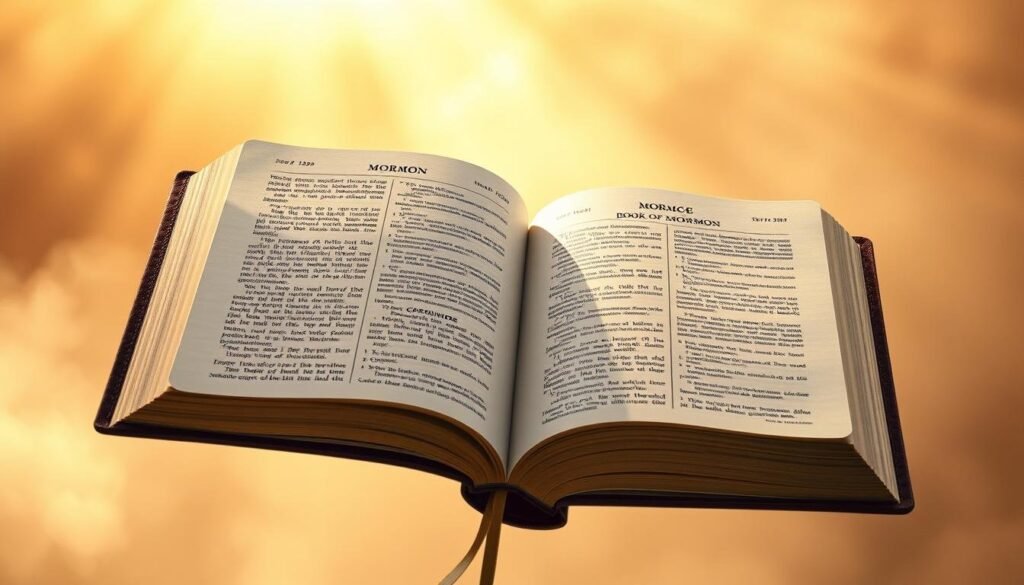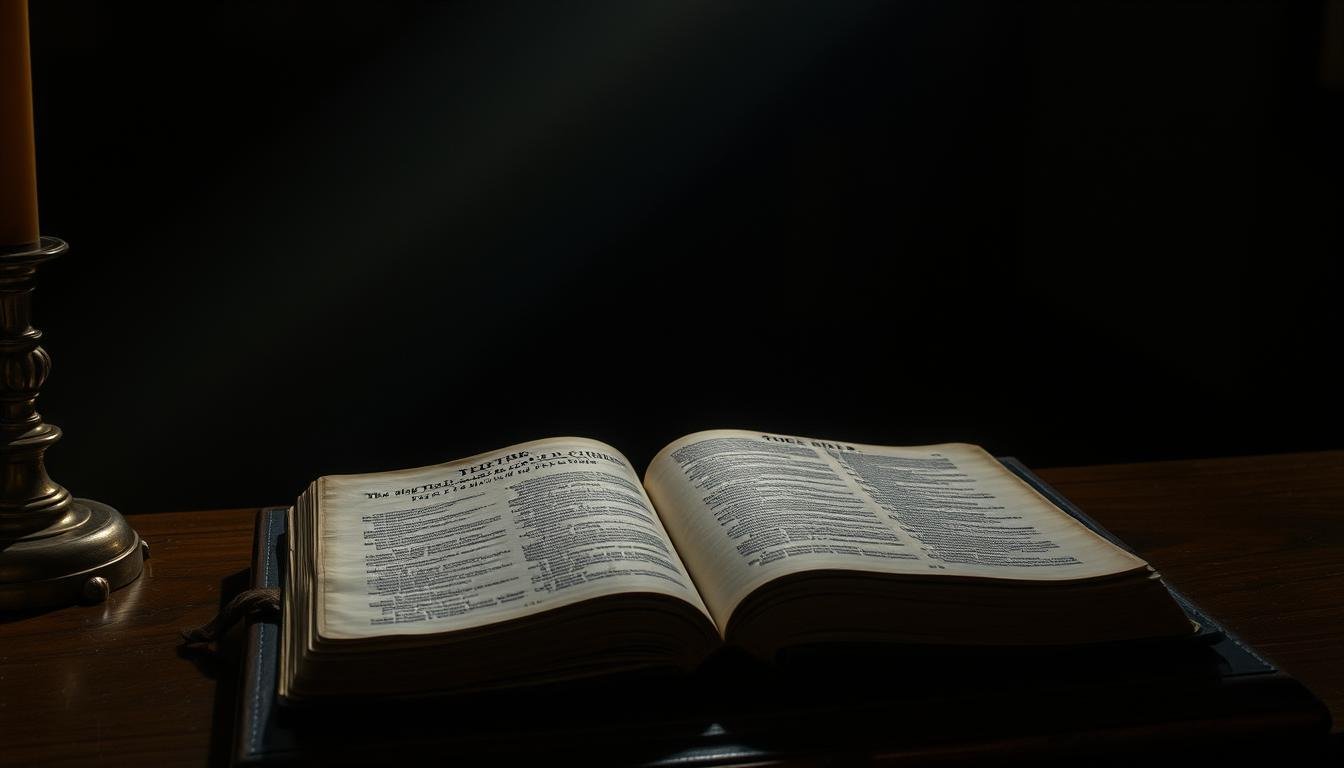Last updated on October 21st, 2025 at 06:16 pm
Does the Book of Mormon Contradict the Bible? Have you ever thought about how the Book of Mormon and the Bible relate? They share some similarities but also have differences.
Exploring if these texts contradict each other is both interesting and enlightening. It involves looking closely at their content and background.
As you explore this topic, you’ll find that some believe the Book of Mormon enhances the Bible. Others, however, see possible disagreements.
Contents
- 1 The Origins and Authority of Both Sacred Texts
- 2 Key Theological Differences Between the Texts
- 3 Alleged Contradictions in Historical Accounts
- 4 Areas of Doctrinal Harmony Between the Texts
- 5 Does the Book of Mormon Contradict the Bible? Scholarly Perspectives
- 6 How to Approach Apparent Contradictions as a Reader
- 7 Conclusion: Does the Book of Mormon Contradict the Bible?
- 8 FAQ
- 8.1 What are the main differences between the Bible and the Book of Mormon?
- 8.2 How do the Old and New Testaments relate to the Book of Mormon?
- 8.3 What is the significance of Joseph Smith’s account of the origin of the Book of Mormon?
- 8.4 How do the Bible and the Book of Mormon approach the concept of salvation?
- 8.5 Can the Bible and the Book of Mormon be used together for spiritual guidance?
- 8.6 How do scholars approach apparent contradictions between the Bible and the Book of Mormon?
- 8.7 What is the role of revelation in understanding the Bible and the Book of Mormon?
- 8.8 How do the Bible and the Book of Mormon portray Jesus Christ?
- 8.9 What are some common criticisms of the Book of Mormon in relation to the Bible?
- 8.10 How can readers navigate the differences between the Bible and the Book of Mormon?
The Origins and Authority of Both Sacred Texts
To understand the differences between the Bible and the Book of Mormon, we must look at where they came from. Their authority and history are tied to how they were written and translated.
Old and New Testament Formation
The Bible is key for Christians, with the Old and New Testaments. The Old Testament, or Hebrew Bible, tells stories and prophecies before Jesus. The New Testament shares Jesus’ life and teachings and the early church’s beginnings. These testaments were made by many authors over centuries.
Translation History and Versions
The Bible’s translation history is complex, with many versions and interpretations. The original texts were in Hebrew, Aramaic, and Greek. The King James Version (KJV), from 1611, is a famous English version still used today.
The Book of Mormon is key to the LDS faith. Joseph Smith translated it from golden plates in the early 19th century. Smith said an angel showed him where the plates were. This story is central to Mormon beliefs, alongside the Bible.
Structure and Content Overview
The Book of Mormon tells stories of ancient people and their dealings with God. It includes teachings, prophecies, and history. Knowing the structure and content of both texts helps us understand their stories and teachings.
Key Theological Differences Between the Texts
When you look at the Bible and the Book of Mormon, you see big differences. One key area is how they view the Godhead.
Biblical Trinity vs. LDS Godhead
The Bible talks about the Trinity. It says God the Father, Jesus Christ, and the Holy Spirit are one God in three persons. On the other hand, the Book of Mormon and other LDS texts say God is three separate beings: God the Father, Jesus Christ, and the Holy Ghost. This changes how people see God and how God interacts with us.
Another big difference is in faith and works. Both the Bible and the Book of Mormon say faith is key. But they differ on the role of works in salvation. The Bible says faith is essential, and works show that faith. The Book of Mormon also values faith but sees works as a big part of salvation, suggesting a closer tie between faith and works.
Restoration Claims vs. Biblical Succession
The Book of Mormon says it brings back true gospel truths that were lost. It claims to restore the true Church of Jesus Christ, which was lost due to apostasy. The Bible, however, is seen by Christians as part of a continuous line of God’s revelation and church history. This shows a big difference in how each faith views God’s work on earth.
Understanding these differences helps us see if the Bible and the Book of Mormon can go together. As you explore these theological differences, you get a better sense of how Christianity and Mormonism have followed different paths in understanding God.
Alleged Contradictions in Historical Accounts
When we look at the Bible and the Book of Mormon, we find some big differences. These issues often deal with the New World in the Book of Mormon and how it fits with the Bible.
New World Setting Challenges
The Book of Mormon tells a story set in the Americas. Critics say there’s no solid proof to back up its claims. They question how the Book of Mormon’s detailed stories of cities, wars, and cultures match up with what we know about ancient America.
For instance, the idea of advanced civilizations in the Americas during the Book of Mormon’s time is debated. Some evidence shows complex societies existed, but linking them to the Book of Mormon is still a topic of research.
Chronological Problems Between Texts
There are also timing issues between the Bible and the Book of Mormon. It’s hard to match up the timelines and events in both texts, especially when they cover the same time periods or figures.
- The Book of Mormon talks about the Nephite and Lamanite civilizations, which some say doesn’t fit with the Bible’s timeline.
- There are problems when trying to line up events, like the reigns of kings or important religious events.
Material Culture and Historical Records
The Book of Mormon’s descriptions of material culture and historical records are also questioned. Critics say some details, like certain technologies, metals, or cultural practices, don’t match up with what archaeologists have found.
Looking into these differences, it’s key to think about the historical context and what we don’t know yet. By doing this, we can better understand the complex ties between the Bible and the Book of Mormon.
Areas of Doctrinal Harmony Between the Texts
The Bible and the Book of Mormon share deep teachings. Christians and members of the LDS faith both value these texts. They show harmony in several important areas. [Does the Book of Mormon Contradict the Bible?]
Ethical Principles and Commandments
Both texts stress the need to love our neighbors and follow the Golden Rule. They also have similar commandments and teachings. For example, the Ten Commandments are found in the Bible and the Book of Mormon.

Both scriptures believe in ongoing revelation. In Christianity, this means the Holy Spirit guides us. In LDS theology, it’s through modern prophets and ongoing revelation. [Does the Book of Mormon Contradict the Bible?]
Jesus’s Role in Both Testaments
Jesus is a key figure in both the Bible and the Book of Mormon. They both say Jesus is divine and the Savior. They also stress the importance of faith in Him for salvation.
In summary, the Bible and the Book of Mormon have many teachings in common. These include ethics, the role of revelation, and the importance of Jesus Christ.
Does the Book of Mormon Contradict the Bible? Scholarly Perspectives
Exploring the Book of Mormon and the Bible’s relationship is key. Scholars look at contradictions from different angles. They use approaches like harmonization, doctrinal objections, and comparative studies.
Harmonization Approaches
Some scholars try to make the Book of Mormon and the Bible match. They look at the texts’ context and backgrounds. They say differences might come from the texts’ purposes and audiences.
Understanding the historical context helps scholars see the texts’ similarities and differences. This way, they can grasp the reasons behind these variations. [Does the Book of Mormon Contradict the Bible?]
Doctrinal Objections
Other scholars focus on the Bible and the Book of Mormon’s theological differences. They point out differences in God’s nature, salvation plans, and Jesus Christ’s role. Critics say the Book of Mormon’s teachings don’t always align with traditional Christian views.
Comparative Religious Studies
Comparative religious studies offer another view. Scholars in this field compare the texts’ structures, themes, and mythological elements. This helps uncover deeper insights into the scriptures’ religious and cultural contexts.
Considering these scholarly views gives a deeper understanding of the Book of Mormon and the Bible’s relationship. Each approach—harmonization, doctrinal analysis, or comparative studies—adds to our knowledge of these sacred texts.
How to Approach Apparent Contradictions as a Reader
When you face apparent contradictions, it’s important to understand both texts well. Reading the Bible and the Book of Mormon requires looking at their historical and cultural backgrounds.
Understanding Ancient Writing Styles
Ancient texts use different styles and structures than today’s books. Metaphors, allegories, and symbols can be tricky to grasp. Knowing these literary tools can clear up seeming contradictions. [Does the Book of Mormon Contradict the Bible?]
Language barriers can cause confusion. The Bible and the Book of Mormon were penned in ancient tongues. Translations might not capture the original intent. Knowing the limits of translation and different views can aid in understanding.
Ancient vs. Modern Worldviews
Ancient cultures saw the world differently than we do today. Their cultural and historical context shapes how we read texts. Recognizing these differences helps us grasp the texts better.
By taking these factors into account, you can gain a deeper understanding of the Bible and the Book of Mormon. This approach helps you appreciate the complexity and wisdom in these sacred writings.
Conclusion: Does the Book of Mormon Contradict the Bible?
Exploring the Book of Mormon and the Bible shows they are both deeply meaningful. They have spiritual and historical value. It’s important to know their origins, theological differences, and where they agree.
Looking at the historical context, theological themes, and scholarly views helps. This way, you can see how the Book of Mormon and the Bible relate to each other.
To make a good assessment, you need to think carefully and be open to both texts. As you study more, you can form your own thoughts about their connection. This will help you understand their roles in your spiritual journey better.
See Also: Why Did Mormons Leave New York?
FAQ
What are the main differences between the Bible and the Book of Mormon?
The Bible and the Book of Mormon differ in their origins and views. The Bible is a collection of texts for Christians. The Book of Mormon is unique to the Latter Day Saint movement.
How do the Old and New Testaments relate to the Book of Mormon?
The Old and New Testaments are part of the Bible. They help us understand the Book of Mormon. The Book of Mormon expands on biblical themes and stories.
What is the significance of Joseph Smith’s account of the origin of the Book of Mormon?
Joseph Smith’s story of the Book of Mormon’s origin is key. It shows why the Book of Mormon is important in the Latter Day Saint tradition.
How do the Bible and the Book of Mormon approach the concept of salvation?
Both texts talk about salvation, but differently. The Bible says salvation comes through faith in Jesus. The Book of Mormon also talks about faith, repentance, and ordinances.
Can the Bible and the Book of Mormon be used together for spiritual guidance?
Yes, many use both texts for spiritual guidance. They see them as complementary, helping understand God’s plan and Jesus’ role. [Does the Book of Mormon Contradict the Bible?]
How do scholars approach apparent contradictions between the Bible and the Book of Mormon?
Scholars look at the historical, cultural, and linguistic backgrounds of both texts. They try to understand the different views and purposes.
What is the role of revelation in understanding the Bible and the Book of Mormon?
Both texts value revelation and divine communication. Readers are encouraged to seek spiritual guidance to grasp the texts’ deeper meanings.
How do the Bible and the Book of Mormon portray Jesus Christ?
Both scriptures see Jesus as the central figure in salvation. They highlight his divinity, mission, and role as Redeemer. [Does the Book of Mormon Contradict the Bible?]
What are some common criticisms of the Book of Mormon in relation to the Bible?
Criticisms include historical and archaeological issues, theological differences, and lack of external evidence for the Book of Mormon’s narrative.
Readers can understand the differences by studying both texts in their contexts. Seeking guidance from leaders and scholars and praying for insight can also help.

Ramona Pearson from the USA is an experienced religious researcher and writer with over 10 years studying Mormon history, beliefs, and culture. She creates accurate, insightful content to educate and inform curious readers worldwide.

